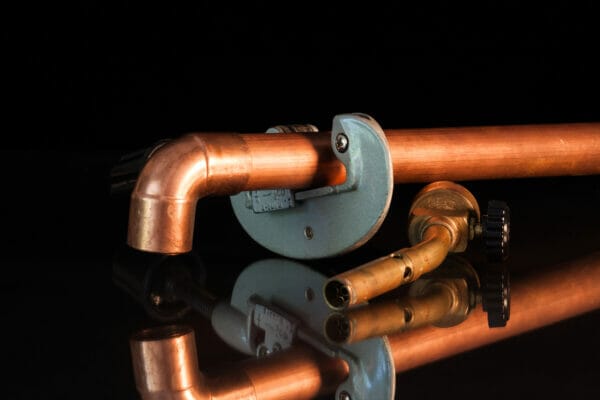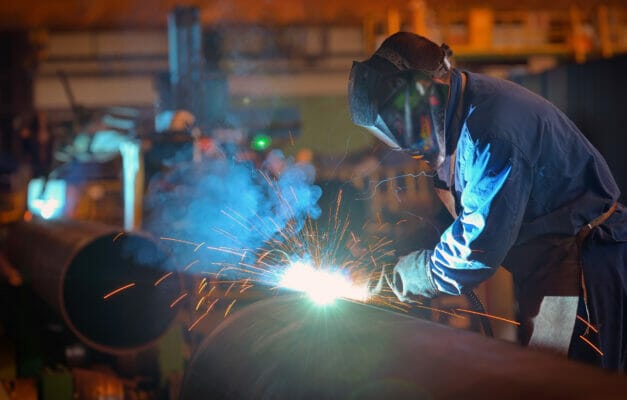Disclaimer: This post may contain affiliate links, meaning we get a small commission if you make a purchase through our links, at no cost to you. For more information, please visit our Disclaimer Page.
A pipefitter fabricator is a skilled tradesman who welds or fabricates components, such as elbows, pipes, flanges, and tees. They engineer piping systems in accordance to the design requirements. Also, they will assemble pipes and pipe fittings according to a specific spool drawing.

Table of Contents
What Are the Roles of a Pipefitter Fabricator?
Pipefitter fabricators play a crucial role in the society’s infrastructure to ensure the institutional, commercial, and industrial facilities are designed safely, mechanically correct, and examined thoroughly for the service the piping system was developed for.
Pipefitting fabrication requires a high level of precision of components. Therefore, in any project involving a network of piping, a pipefitter fabricator should comprehensively plan, schedule, and execute according to the design, timing, and budget requirements.
A pipefitter fabricator has the capacity to manufacture and install large and complex, low- and high-pressure fabricated piping systems.
In addition, the fabricator can perform internal vessel, tower, and tank activities, including removal and reinstallation of weirs, trays, demister, baffles, and sparring equipment.
They may also carry out vessels and equipment piping systems blinding necessary for vessel entry and production and maintenance activities.
Moreover, when a pipefitter fabricator is assembling and installing pipes, they may need to shape the metals and other materials to fit the specific use.
That might involve creating a blueprint or sketch of the pipe installation, choosing the type and size of pipe, and developing a plan for installation purposes.
What Does a Pipefitter Fabricator Do Each Day?
A pipefitter fabricator divides piping work phases into sub-processes. First, a fabricator will mark the pipe as per the design drawing requirement (the concerned supervisor usually verifies this before cutting).
Typically, a pipefitter fabricator can cut the pipelines into the desired requirements. Then, they create the work order automatically to the chosen spools requiring cutting.
For instance, carbon steel pipes are cut by gas cutting and grinding, alloy steel pipes through flammable cutting or grinding, and stainless-steel pipes by grinding.
Plasma cutting is also often required for beveling the pipe system ends for welding and cutting the branch holes needed. The pipefitter fabricator will bend pipes to save fitting and welding work (usually, every bend can save at least two weld seams).
A pipefitter will use dye stamping, tagging, or paint marking to transfer pipe heat numbers to the cut pieces before cutting the pipelines.
Moreover, a pipefitter fabricator performs inspections to ensure the fabrication process has been completed and meets the specifications of the project. Piping systems that do not pass the requirement should be repaired and reinspected.
Note that piping that needs to be painted requires another inspection before being released for construction.
Furthermore, a pipefitter fabricator lays out and fabricates piping layouts with the assistance of other welders and fitters as required.
In addition, they manufacture various structural items like piping conduits, pressure vessels, and platforms.
A pipefitter fabricator may also be involved in the fitting phase, where multiple components of the pipes are attached together.
What Tools and Equipment Do Pipefitter Fabricators Use?
Pipefitter fabricators rely on various specialized equipment to work safely and efficiently. However, most of these tools designed to handle medium and large-scale projects are used mainly in the workshop.
The workshop offers the appropriate space, reliable security, quality control, and protection from the weather.
Note that fabricators should consider the size of the assembly since transportation might be an issue. In such instances, sub-assemblies are the feasible way to transport large projects. The pipefitter will prefabricate pieces of piping systems in factories rather than a construction site.
That ensures proper utilization of better tools and working conditions, resulting in better quality and higher productivity. It also lowers the lead time at the construction site.
But a pipefitter fabricator can also complete several pipe fabrications tasks for small-scale projects in the field.
Some tools that allow pipefitter fabricators to create complex precision piping systems include pipe benders, flangers, jacks, saws and thermal cutting equipment, welding machines, rotating equipment, and rigging and transportation equipment.
Is Being a Pipefitter Fabricator Difficult?
Some pipe fabrications are straightforward, while others entail numerous intricate steps or require unconventional thinking to solve a piping issue.
Regardless of the challenge, the skill level of the pipefitter fabricator will make the difference in offering exceptional fabrication solutions.
Since pipefitters deal mainly with dangerous gases and liquids, specific instruments and materials in the piping system should be considered.
Also, the approach to using consistent techniques, tools, and standards should be considered to deliver superior results even when working in the most challenging environments.
How Much Does a Pipefitter Fabricator Make?
The average salary for pipefitters is $57,371 and has the possibility of earning $9,716 in overtime.
The salary increases as the fabricator gains more experience. Note that the BLS projects that the pipefitting industry will grow by about 7% by 2028.
What Is a Mechanical Pipefitter?
A mechanical pipefitter works with materials such as metal and is responsible for assembling and fitting parts of production machinery. The professionals work in different fields, including mining, the auto industry, or even the military.
A mechanical pipefitter fabricates, installs, and maintains heavy machinery.
They work with precise specifications to operate machines and tools to mill, grind, and shape materials into a specified form before assembling them to the final product.
The duties of a mechanical pipefitter also include measuring fittings accurately, troubleshooting, and repairing mechanical equipment when necessary.
How To Become a Mechanical Pipefitter?
To become a mechanical pipefitter, you should complete a training program or apprenticeship in pipefitting. The course duration might vary but often takes 3-5 years.
A training apprenticeship is a binding commitment made by the trainee and employer for the term of the agreement.
The training you select should be accredited by the Department of Higher Education and should provide a combination of class coursework and hands-on experience.
Some mechanical pipefitters may require additional qualifications, including machine safety and handling or a certificate in engineering studies. You may also need to attain certification for using forklifts.
These can be achieved through the completion of short courses from a registered training organization (RTO).
It would be best if you are also comfortable working in confined spaces or at heights. Besides, a mechanical pipefitting career requires excellent problem-solving and technical skills.

Does A Pipefitter Weld?
Both pipe welders and fitters should be able to create a robust connection between pipes and understand how piping fits together.
Generally, welding is one of the duties that a pipefitter fabricator performs on a job. However, the pipefitter should be skilled in pipe welding.
The skilled pipe fitters can put down the welds through:
Arc Welding: a pipefitter fabricator can do arc welding, which requires an electrode and works by creating an electric arc from a direct or alternating current.
There are various types of electrodes used in welding. Arc welding is often used for thick, heavy pipe metals, including cast iron.
MIG Welding: One of the quickest forms of welding, MIG uses inert metal gas. It entails a wire feed going through an electrode inside a welding handgun.
Typically, pipefitters use this process on stainless steel, mild steel, and aluminum.
TIG Welding: This uses inert tungsten gas to create the arc. It is used for metals like alloys.
References
https://www.indeed.com/career/pipefitter/salaries?from=careeradvice-US
https://www.tws.edu/blog/pipefitting/what-type-of-welding-do-pipefitters-use/
